
FRIENDS OF LAKE KEOWEE SOCIETY






By Dave Metzger, Treasurer, FOLKS
As we move through our 32nd year pursuing our mission, FOLKS remains one of the best resourced and healthiest lake protection organizations in the Southeast. Much of this is due to the generosity, determination, and foresight of our founding generation of members. Many, if not most lake advocacy groups, now suffer from dwindling funds, unmotivated constituents and a lack of galvanizing issues that can be addressed locally. FOLKS is amongst the few organizations well positioned to sustain its mission in an uncertain future.
There are significant knowns that anchor both our mission and the need for our presence as an advocate and voice for the community. Oconee Nuclear is licensed through 2054. The recent Bad Creek relicensing doubles the “drop” capacity of the Bad Creek geological battery, virtually insuring it as a critical power generation resource for decades to come. This should secure comparatively stable water levels in the northernmost lakes of the Upper Savannah watershed for the foreseeable future.
Along with this activity though, come considerable unknowns. Accelerated water cycles reflecting warmer ocean temperatures already display signs of more violent storm conditions and greater concentrations of run off. Both of these weather dynamics may pose threats to basic lake ecosystems.
adapt to the inevitable changes in our environment:
Internally, we continue to amend our operating model to negotiate the mounting costs of people, engagement and technology. Our biggest investment over the next several years will be to develop more digital platforms to communicate with and impact our constituents. Digital platforms lean toward sustainability and promise a more efficient and less costly operating model.

Externally, we continue advocacy and education programs to support a healthy lake ecosystem. Throughout the Bad Creek relicensing process, we were a strong voice advocating for several million dollars of conservation funding to fellow environmental organizations operating in the watershed. Over the past 5 years we have directed or partnered with other civic organizations to allocate well over $250,000 to habitat enhancement and environmental protection. Critical issues and challenges will inevitably present themselves down the road. The Upper Savannah region is projected to be the most ecologically vibrant and healthy of the major watersheds in the Southeast. This alone will continue to attract people and development, all of them seeking clean water, inherent beauty, and unique recreational opportunities.
Shoreline or contiguous development may be limited by volume of available land but may still raise significant challenges for the lake and its feeder streams. The future may be uncertain, but it is undeniable that the pristine nature of Lakes Keowee and Jocassee will continue to attract people seeking water, beauty, and recreation.
Organizationally FOLKS is well prepared to assess and
FOLKS stands right alongside all of this as a vocal advocate for the community. These lakes, rivers and streams are arguably our most precious regional resource. As is evidenced in this edition of KEOWEE, which pays tribute to local advocates and conservationists, our most important resource is those of you willing to dedicate your time and energy to ensuring a sound future for the community.

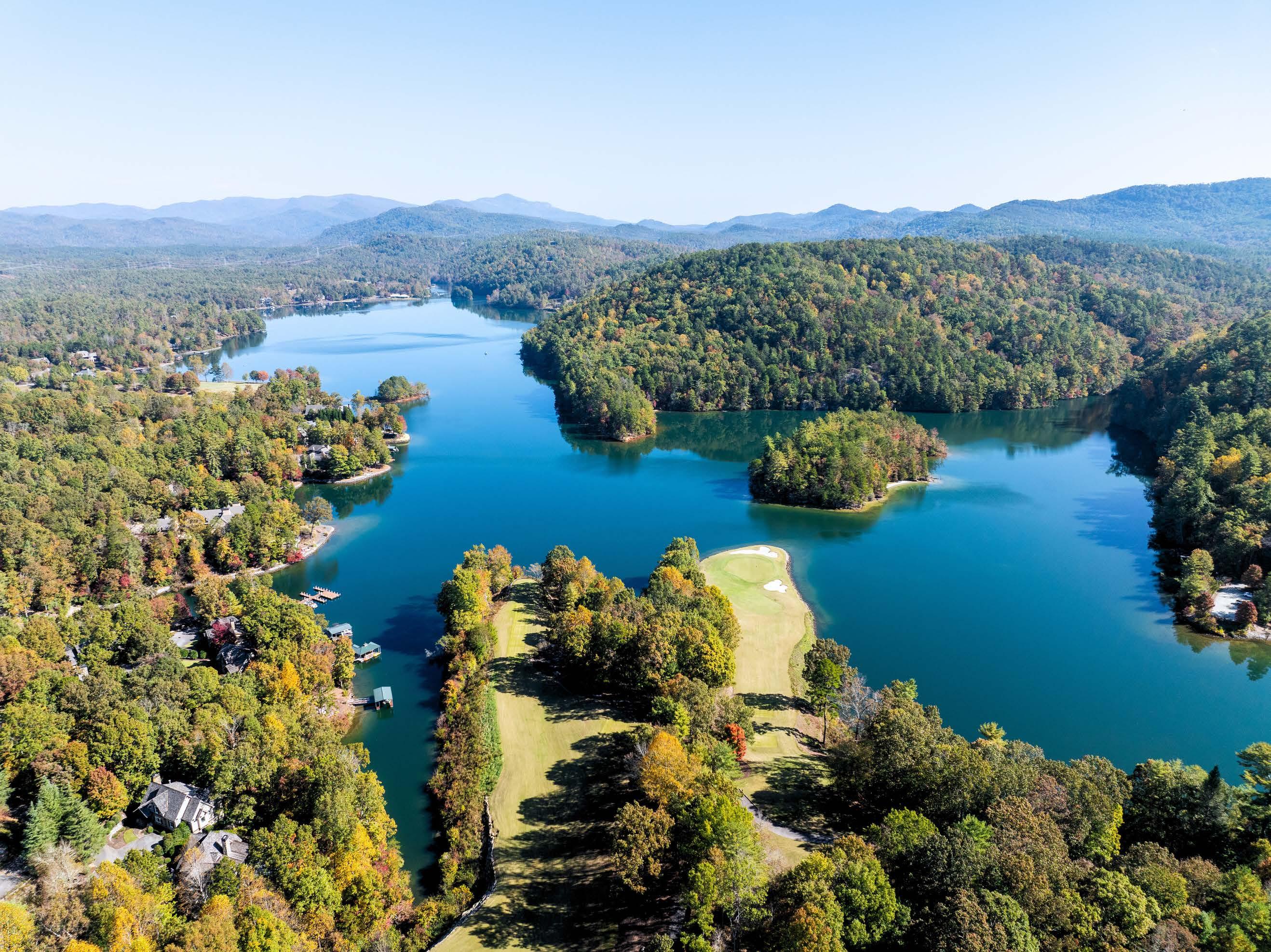
P r o s p e c t i v e b u y e r s o f t e n a s k o u r
t e a m “ w h a t ’ s t h e a r e a ’ s g r e a t e s t
a t t r a c t i o n — t h e c o m m u n i t i e s , t h e
g o l f c o u r s e s , t h e c l u b s ? ” “ L a k e K e o w e e ” i s o u r r e s p o n s e .
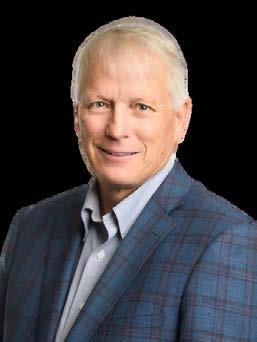
By Dale Wilde, President, FOLKS
Below is a detailed list of conservation groups, collaborative initiatives, and state agencies active in Oconee and Pickens Counties, and regional resources in South Carolina. The organizations listed focus on preserving the unique natural landscapes of Upstate South Carolina through various conservation strategies, ensuring the protection of valuable ecosystems and scenic areas for future generations. They also play crucial roles in preserving natural resources and promoting environmental sustainability in their respective areas.
Established in 1993, FOLKS is committed to preserving the Lake Keowee Watershed through its mission of advocacy, conservation, and education. As stakeholders in the watershed, FOLKS provides a strong voice and valuable input on major developments and reauthorizations undertaken by Duke Energy. FOLKS also has a robust scholarship program for juniors and seniors in Pickens and Oconee Counties. KeoweeFOLKS.org, (864) 719-0599
KPCB is an organization dedicated to promoting environmental stewardship, focusing on litter prevention, beautification, and waste reduction in Pickens County, South Carolina. Their mission is to engage individuals and organizations in Pickens County to take proactive steps toward preventing litter, enhancing community aesthetics, and promoting sustainable waste management practices. TinyURL.com/ythcu4an, (864) 898-5256
The LKSWPT was formed in 2017 with funding from the Keowee-Toxaway Reauthorization as a multi-jurisdictional partnership whose aim is to protect the drinking water quality in the Lake Keowee watershed, which serves Pickens, Oconee, and Greenville counties. The team includes members such as Greenville Water, Seneca Light & Water, Pickens County, Oconee County, Advocates for Quality Development, Upstate Forever, and FOLKS. Duke Energy, and Clemson University’s Center of Watershed Excellence
also support this initiative. LakeKeoweeWatershed.org
This county department focuses on enforcing litter laws and organizing clean-up efforts to maintain the county’s cleanliness. They work closely with volunteers and community groups. PickensCountySC.gov, (864) 898-5905
The Pickens Soil and Water Conservation District is focused on promoting the wise use and management of natural resources within Pickens County, South Carolina. Their mission promotes the conservation of natural resources by working with landowners, farmers, and the community to implement best management practices for soil and water conservation. PickensSoilAndWater.com, (864) 878-6155
This organization focuses on preserving natural landscapes and biodiversity in the Upstate region. Naturaland Trust acquires and manages lands for conservation purposes, aiming to protect habitats, scenic views, and recreational areas. NaturalAndTrust.org, (864) 467-2521

Part of the global Nature Conservancy network, this chapter focuses on conserving land and water in South Carolina, including the Upstate region. They engage in land acquisition, conservation easements, and habitat restoration projects. Nature.org/SC, (864) 233-4988
This regional nonprofit operates in ten Upstate counties, including Pickens, Oconee, and Greenville. Its mission focuses on land conservation, water quality protection, and advocating for smart growth policies. They engage in land protection projects, community outreach, and policy advocacy to safeguard the area’s natural resources. UpstateForever.org, (864) 250-0500
AQD supports projects, legislation, and development that enhance the overall quality of life for residents while monitoring compliance with the letter and the spirit of local ordinances. They work diligently in both Oconee and Pickens Counties to protect our watershed, public safety, and the environment. AQD is also a stakeholder on key upstate lake programs such as Keowee-Toxaway Relicensing Agreement, Duke’s Habitat Enhancement Program, and Lake Keowee Source Water Protection Team efforts. AQDUpstate.com
KOBA is a nonprofit whose mission is to restore and maintain the natural beauty of Oconee County through education, awareness, cooperation, and action. KOBASC.com, (864) 614-1281
Oconee County Litter Control focuses on enforcing litter regulations and supporting local clean-up activities. They collaborate with citizens and organizations to keep the county clean. OconeeSC.com, (864) 638-4218
The district provides resources and support for soil and water conservation efforts in Oconee County OconeeSoilAndWater.org, (864) 638-2213
The Extension Service rovides research-based information and educational programs on natural resource management. Clemson.edu/extension, (864) 656-3382
Though primarily focused on Western North Carolina, Conserving Carolina also works in parts of Upstate South
Carolina. They focus on land and water conservation, aiming to protect and restore natural areas for future generations. ConservingCarolina.org, (828) 697-5777
While primarily based in North Carolina, this organization also works in areas that extend into Upstate South Carolina. They are dedicated to conserving the natural and cultural heritage of the Blue Ridge Foothills. FoothillsConservancy.org, (828) 437-9930
PalmettoPride is a state-wide non-profit organization dedicated to reducing litter and promoting environmental stewardship in South Carolina. They organize various programs, including the “Adopt-A-Highway” initiative, educational outreach, and community clean-up events. PalmettoPride.org, (877) 725-7733

As a state agency, SCDNR plays a crucial role in managing and protecting natural resources across South Carolina, including the counties of Pickens, Oconee, and Greenville. They provide guidance, enforcement, and support for conservation efforts statewide. DNR.sc.gov, (803) 734-3886
Established in 1931, SCWF has been safeguarding the state’s wildlife with proven scientific methods to preserve the health of our delicate ecosystems. They also advocate to protect our natural resources through sound legislation and policy decisions. SCWF.org, (803) 256-0670



BY MELISSA HIGGS, Community Engagement Director, FOLKS
South Carolina Department of Natural Resources (SCDNR) Region 1 Law Enforcement Captain DJ Riley recently retired after 31 years with the State of South Carolina. Over the course of his career, he has been promoted through the ranks from sergeant, to lieutenant, and then to captain of the 12 Upstate counties and of 62 officers. He is also a graduate of the FBI National Academy.
A tremendous resource for FOLKS, Capt. Riley has shown outstanding leadership in all efforts to address the issues of boating safety and littering. Beyond his work in the field, he has helped with virtual town halls for FOLKS, giving people the opportunity to ask questions about law enforcement. The level of care and dedication he has shown for the community will serve as an example for future generations.
As a way to pay tribute to such a
successful career, I interviewed Capt. Riley about key moments with SCDNR and his thoughts about the organization that has impacted so much of his life.
Q Did anything surprise you about your job with SCDNR?
A I had been a reserve deputy for three years before I became fulltime. We worked with hunting, fishing, and boating licenses. I guess you could say the growth on the lake has been surprising. There used to be smaller boats and less development. People didn’t want to live out by the lake. That has certainly changed.
I believe most people would be surprised by all the many facets of the SC Department of Natural Resources, in particular, the many divisions within the department,
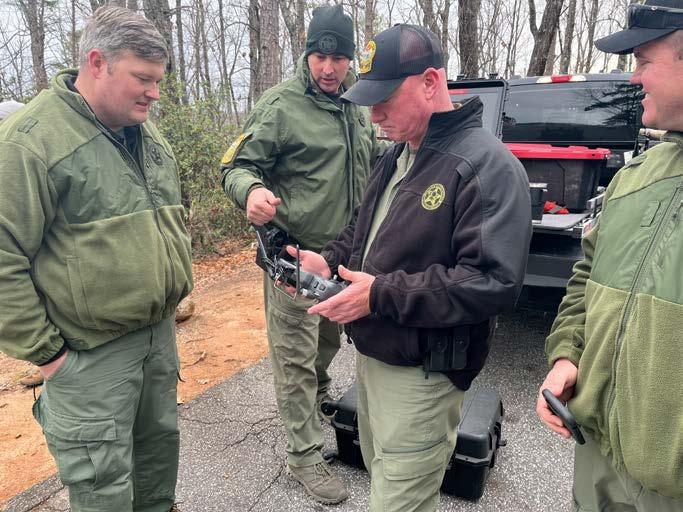
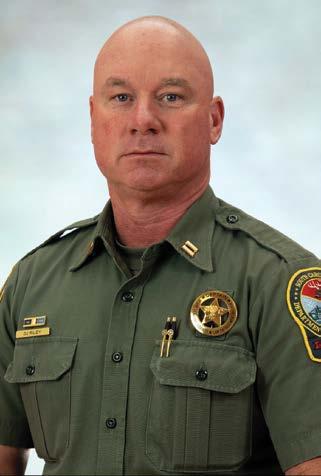
like fisheries, the biologists, marine resources, geodetic surveying, the educational groups and of course, law enforcement. While the general public is enjoying the outdoors, know that SCDNR has been or is actively involved in order to make life experiences better.
Q What did you enjoy about working with SCDNR?
A First and foremost, the people that work with SCDNR and the relationships we built are very important to me. In addition, meeting different people and groups within the community stands out. For example, being in “details” for elected officials was rewarding.
The day-to-day job responsibilities and duties were ever-changing, such as the different seasons from boating to hunting and working in the mountains or facilitating school programs. It was always an evolving job; each day was always different. I enjoyed the flexibility of the job
(continued on page 10)
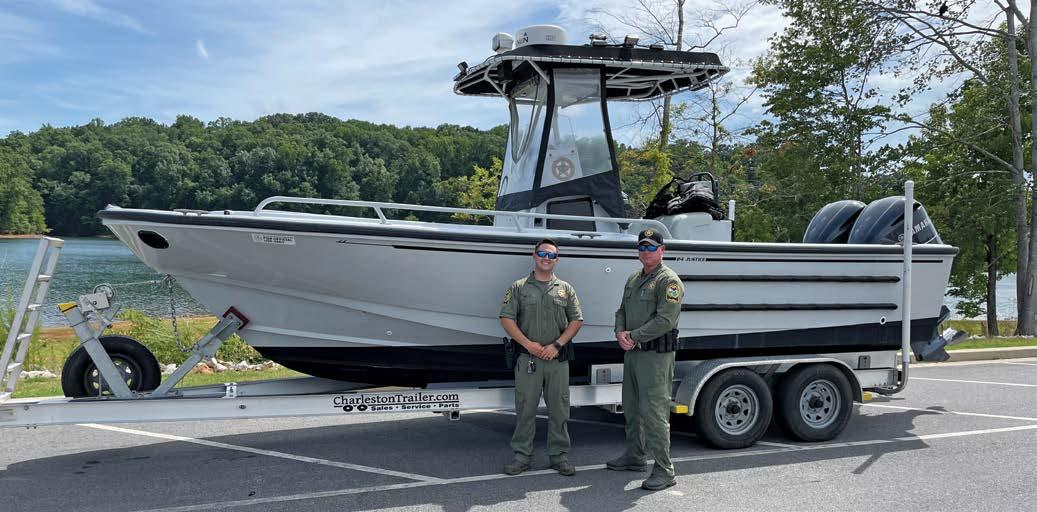
Q What is one thing that is most needed to support SCDNR?
Q How would you describe your experiences with SCDNR?
Q Do you think there is still interest in being a game warden?
A Definitely! SCDNR has hired 20 to 25 officers statewide year after year, over the last five years, and normally has 350-400 applicants. I firmly believe there is a desire among many to be in this particular line of law enforcement and protect our natural resources as well as educate others on the importance of conservation.
A I think if the public would continue to educate themselves on the regulations for hunting, fishing and boating, it would help. In general, people need to continue to support SCDNR in the protection of our natural resources for our future generations to enjoy it.
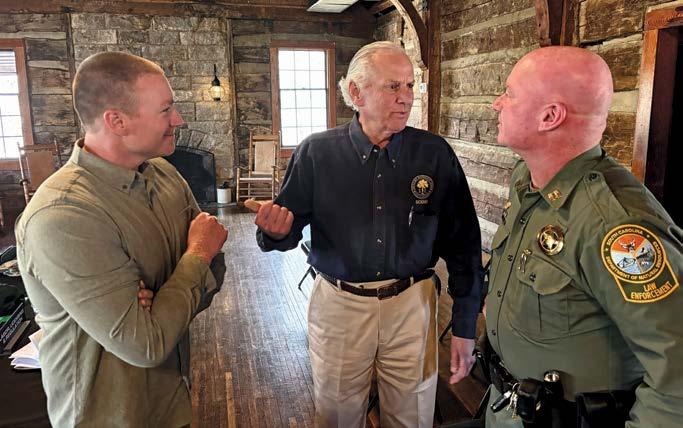
A The day-to-day differences in the job itself made working with SCDNR most enjoyable. The relationships and opportunities are some that I will always cherish. I have passed down many experiences to my son and my grandchildren. I am proud of the lifelong friendships, and I have achieved many goals and accolades that, without SCDNR, I may never have had the opportunity to pursue.
Q What do you plan to do now that you are retired?
A I am still a reserve officer, and I will teach classes. I will enjoy being with my son, who is now a fulltime officer with SCDNR. My wife and I have had longtime dreams of traveling and hope to do a lot of that soon. We have three grandchildren that are growing up way too fast, so we plan to enjoy as much time with them as possible.
BY THE LAKE KEOWEE WATERSHED PROTECTION TEAM
Lake Keowee plays a vital role in the Upstate, not only for energy production and a critical source of drinking water to more than 250,000 residents in Oconee, Pickens, Anderson, Laurens, and Greenville Counties, but also for recreational boating and fishing. On any given day, you will see boaters, jet skiers, paddleboarders, kayakers, and fishermen enjoying the pristine waters in our backyard. It is not just us who enjoy the lake; Lake Keowee is home to a variety of fish, amphibians, reptiles, birds, and mammals, providing a critical habitat and source of food.
We all have a shared responsibility to keep the lake clean from litter, runoff, and other negative impacts that affect its vitality.
The Lake Keowee Source Water Protection Team (LKSWPT) is a 501(c)(3) nonprofit organization formed by Duke Energy in 2017 to monitor and protect the water quality of Lake Keowee and the Lake Keowee Watershed. LKSWPT consists of eight organizations working together to ensure Lake Keowee’s water is safe for residents, recreation, water consumption, and energy production. The organization achieves these goals by providing educational information, implementing grants for septic system repairs and replacements, and securing conservation easements. The LKSWPT Board of Directors is comprised of representatives from Friends of Lake Keowee Society (FOLKS), Seneca Light & Water, Greenville Water, Advocates for Quality Development (AQD), Oconee County, Pickens County, Upstate Forever, and Duke Energy. The Team is also supported by Clemson Center for Watershed Excellence, Clemson Extension–Water Resources, and JSF2 Consulting.
LKSWPT is positioned to apply for grants from the SC Department of Environmental Services (SCDES), which have a direct and tangible influence on water quality. The primary impacts to water quality are from nonpoint sources, such as runoff from fertilizer and pesticides, faulty septic systems, animal waste, and sedimentation. LKSWPT is known for collaboration, and our successes simply would not happen
without the team’s shared leadership and local knowledge. Since the completion of the Watershed-Based Plan for the Little River and Keowee River–Lake Keowee Watersheds in 2020, we are proud of our milestone achievements as illustrated in Figure 1 (on page 12), and listed below:
• Secured $730,000 in grant funding to directly assist homeowners and property owners in the Lake Keowee watersheds.
• Contracted for repair or replacement of over 140 faulty septic systems reducing flow of waste and harmful bacteria by 25 million gallons of contaminated wastewater and bacteria annually into sensitive drinking water sources (refer to chart below).
• Continued to educate residents of best practices through our website, collaborated with Clemson Center for Watershed Excellence and Clemson Extension Water Resources, and outreach seminars.
• Provided funding to assist in the protection of over 10,000 linear feet of streams and 220 acres of property through conservation easements.
• Developed watershed-based plans for Cane—Little Cane Creek, Little River, and Keowee River—Lake Keowee watersheds, and successfully secured four 319 grants from the SC DES.
Lake Keowee has more than 300 miles of shoreline, some of which pose diverse challenges as numerous properties have
(continued on page 12)
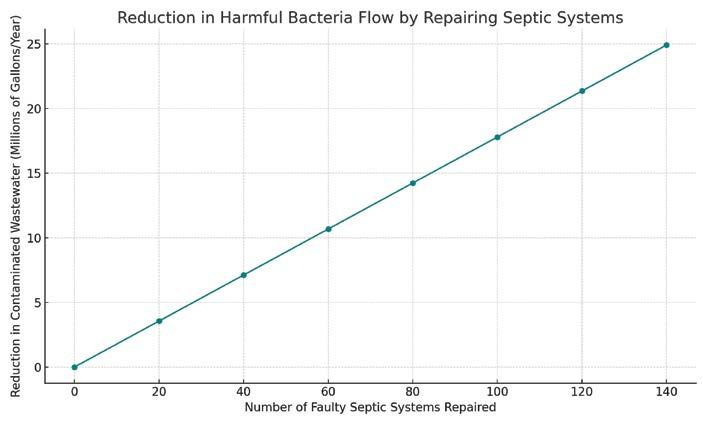
(continued from page 11) septic systems over 20 years old and are subject to failing. Recent and exponential growth over the past few years has resulted in increased runoff and sedimentation, resulting in bacteria and nutrient overloading which can pose human health risks to lake users and cause algal blooms.
Challenges often give rise to creative solutions, such as the creation of the Septic Findand-Fix Program. Repairing or replacing septic systems can be prohibitively expensive, with costs ranging from $8,000 to $40,000 depending on site conditions and system types. Many homeowners struggle to cover these costs, which makes the septic repair assistance provided by LKSWPT a valuable resource for the local community. Through feedback from program participants, we are continually improving on promoting program awareness and communications with property owners and licensed septic contractors.
Lake Keowee is not just a local treasure; it’s part of a regional sustainability network. LKSWPT’s work aligns with groups like Upstate Forever, advancing efforts in land conservation and protecting water quality, Duke Energy, SCDES, and the EPA for financial assistance, and Clemson Extension and the Center for Watershed Excellence for educational support. Together, these partnerships amplify our impact — protecting ecosystems across the Upstate.









The following quotes from property owners who participated in the Septic Find-andFix Program highlight LKSWPT’s success:
• “Please, please use this program, it is well worth it, keeping our lakes clean is important!”
• “This grant program should be considered by anyone who has septic system issues on Lake Keowee. It allows additional and supplemental funding to improve your septic system and water quality.”
• “I highly recommend the program: the process from start to finish was quick and easy.”
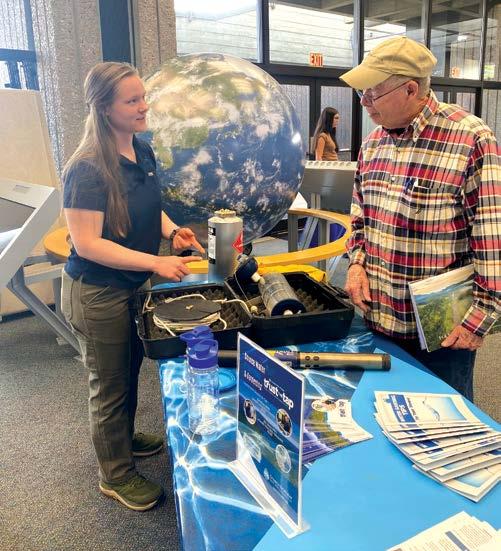
Each of the Directors brings a unique and passionate perspective to the Team as shown in the brief introductions below.
• Why I Got Involved: To make a positive contribution in protecting the Lake Keowee watershed from environmental impacts.
• Background: B.S. in Biology, M.S. in Land and Water Resource Management, 30 years of federal government and consulting experience managing environmental programs.
• What the Lake Means to Me: Whether watching the reflecting sunlight, kayaking the quiet coves, or sharing the sunset with friends on the dock, Lake Keowee provides a sense of tranquility.
• Why I Got Involved: Working collaboratively with this group of organizations to preserve and protect the quality of Lake Keowee for both recreation and drinking water consumption has been a keystone of work for Upstate Forever’s Clean Water Team. Working alongside LKSWPT is an added benefit!
• Background: Clean Water Director, Upstate Forever.
• What the Lake Means to Me: Lake Keowee serves as a critical drinking water as well as hydropower source for the region. Protecting it and maintaining its natural beauty is a high priority for our organization.
• Why I Got Involved: Lake Keowee’s watershed plays an important role in the quality of stormwater. Ensuring the contributing watersheds are well protected confers a variety of ecological benefits to the region from improving water quality to supporting wildlife.
• Background: Currently serving as Pickens County’s Stormwater Manager with over 10 years of environmental science experience.
• What the Lake Means to Me: Protecting this unique resource will enhance quality of life and provide lasting benefits to the surrounding communities now and for generations to come.
• Why I Got Involved: I serve on behalf of Oconee County and the public and business interests that both enjoy and depend on the lake.
• Background: My background is in Urban and Regional Planning along with experience at local, county, regional, and state levels. I have a desire to serve my community.
• What the Lake Means to Me: As much as I enjoy our lakes and rivers personally, I also realize that water is a resource that serves us in many ways, one that can no longer be taken for granted.
• Why I Got Involved: To ensure long-term sustainability of Lake Keowee’s water resources and guarantee all uses are protected for generations to come.
• Background: B.S. in Biology, 40 years of hydropower experience managing federal operating licenses and implementing environmental and recreation initiatives.
(continued on page 14)
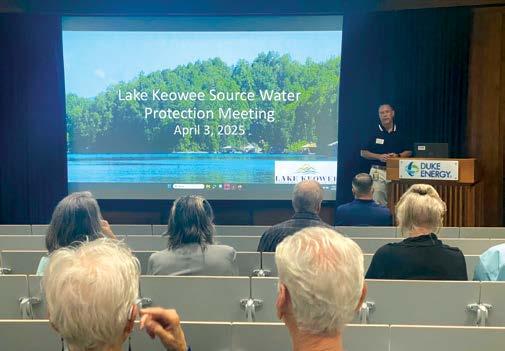
(continued from page 13)
• What the Lake Means to Me: Whether it’s skipping rocks during a sunset stroll along the lake shoreline with my beloved wife or teaching my grandchildren the art of fishing, whatever the passion, with a little imagination, Lake Keowee’s possibilities are limitless.
Scottie Ferguson, JSF2 Consulting
• Why I Got Involved: Lake Keowee is among the cleanest lakes in the Southeast, and I am proud to be part of the effort to maintain its water quality and ecological health.
• Background: B.S. in Biology, University of South Carolina. Former Environmental Lab Director and Stormwater Manager, currently serving as a Technical Consultant for LKSPWT.
• What the Lake Means to Me: Remarkably clear and clean water.
Anaston Porter, Clemson University Cooperative Extension Service
• Why I Got Involved: Clemson University Cooperative Extension Service (CUCES) has partnered with LKSWPT for many years as a technical advisor. The CUCES is committed to supporting outreach efforts and actionable strategies that address local water quality and quantity challenges in South Carolina. This valued partnership creates a unique opportunity to continue the important work of sustaining productive lands and healthy ecosystems in our region, as well as enhancing efforts to reduce bacteria, nutrient, and sediment loads to our waterways.
• Background: Water Resources Agent, Pickens County Clemson Extension. Three years of experience in natural resources education outreach. B.S. Wildlife & Fisheries Biology, M.S. Agricultural Education.
• What the Lake Means to Me: As a water resources professional and lifelong Pickens County resident, I am committed to protecting our waterways for the benefit of future generations. Lake Keowee is a vital resource for our local community, offering both ecological value and recreational opportunities for residents and visitors alike. Having grown up with this lake as a constant in my life, I take great pride in contributing to its preservation and ensuring its continued health and beauty.
The LKSWPT performs its role unselfishly through the volunteer hours of its directors and has been recognized for its efforts
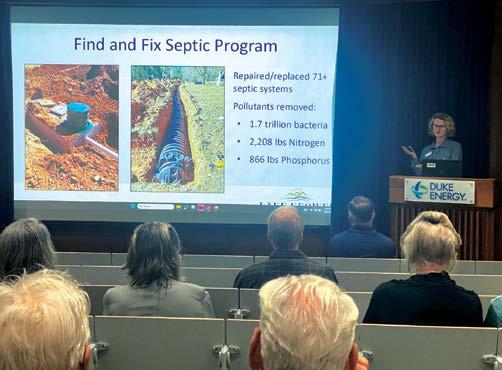
over the years. Specifically, FOLKS recognized Ms. Erika Hollis, LKSWPT Chairperson, for her leadership and positive impact within the Lake Keowee Watershed. In addition, the LKSWPT was presented the The Izaak Walton League of America Award in 2024 for its conservation efforts to promote the sustainable use and enjoyment of our natural resources.
Whether you’re a weekend visitor or a full-time resident, the health of Lake Keowee shapes our region’s future. Its story is our story, one we all have a stake in telling and protecting.

INVOLVED. GIVE BACK. GROW THE VISION.
• If you have a faulty system, apply for financial assistance to offset the cost of repairs at Lake Keowee Septic Tank Program | Source Water Protection Team (lakekeoweewatershed.org/septic)
• Educate yourself on best practices to maintain your septic system at Be Septic Safe (clemson.edu/extension/water/resources/be-septic-safe.html)
• Join FOLKS at Friends of Lake Keowee Society (keoweefolks.org)
• Stay connected through social media.
• Volunteer for FOLKS Lake Sweeps and Adopt-an-Island.
• Consider protecting land from future development through establishing a conservation easement.
• Plant native species along the shoreline.
• Attend outreach events, webinars, and speaker series

We invite members to submit their original Lake Keowee photography for consideration in an upcoming publication. We’re looking for a wide range of subject matter — people, landscapes, action shots, waterscapes, wildlife, your favorite places, hidden gems, rare sightings, etc. Photo requirements include high resolution, a minimum of 8''x10'', jpeg format, and must be taken by a FOLKS member. Please include member name, photo title and photo location when submitting. Email submissions to folks@keoweefolks.org with the subject line “PHOTO FOR PUBLISHING.”

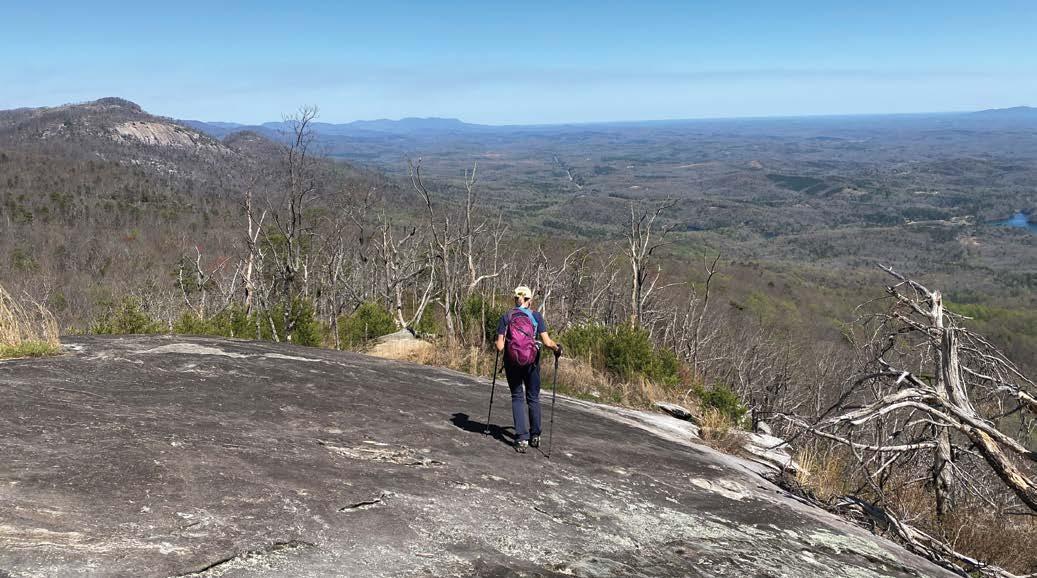
BY MELISSA HIGGS, Community Engagement Director, FOLKS
FOLKS was fortunate enough to sponsor a recent speaker event with the Foothills Trail (FT) legend, Heyward Douglass. The former Executive Director and long-time board member of the Foothills Trail Conservancy (FTC) is their current Projects Coordinator. He holds two degrees in the biological sciences from Clemson University. Heyward also served in the U.S. Air Force, spent years working as a freelance pilot, and flew as an administrative pilot for Clemson University for 30 years. He has a lifelong passion for hiking and the outdoors. Heyward has hiked the entire Foothills Trail many times since he first discovered it in the 1980s, and he assisted with major revisions of the guidebook for the trail. He has also hiked the entire Appalachian Trail. He loves helping maintain the Foothills Trail and promoting it.
The 77-mile-long Foothills Trail was built in partnership with the Foothills Trail Conference (later Conservancy), Clemson University, Crescent Properties, and Duke Power (later Duke Energy) from 1974 through 1981, following a path proposed by the Sierra Club. The FTC board originally consisted of Duke Power employees but is now a volunteer board. Duke Energy still maintains 43 miles of the FT due to a stakeholder agreement for the
relicensing of the Bad Creek Pump Station. The trail passes through lands that belong to or are managed by the U.S. Forest Service, the South Carolina Department of Natural Resources, South Carolina State Parks, Duke Energy and the North Carolina Department of Environmental Resources. For both day hikers and backpackers, the
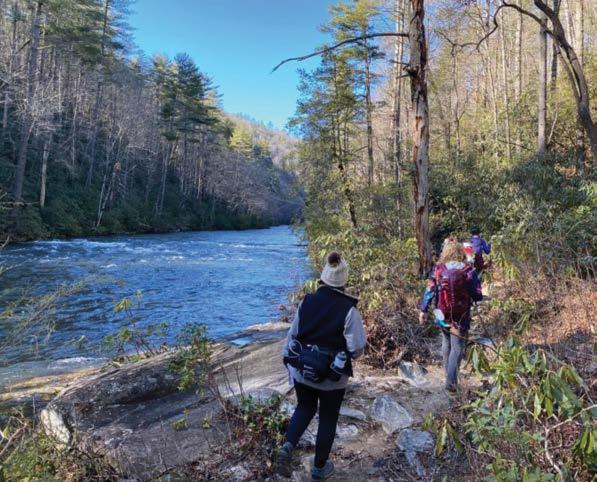
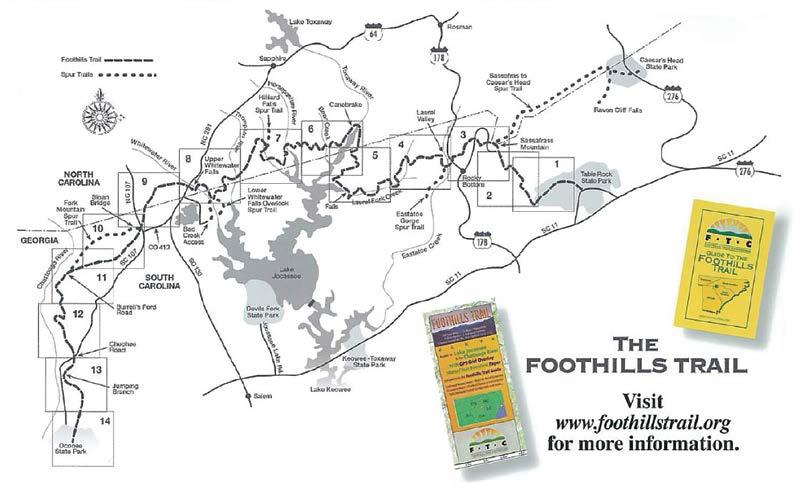
trail offers a unique way to experience the beauty of conservation lands from Oconee State Park to Table Rock State Park. However, the FT can also be demanding with its elevation changes in some sections, so if you plan to hike, be sure to read the Foothills Trail Guidebook (foothillstrail.org/shop).
A quick glance at the FTC website or social media and you will see Heyward Douglass in action. A behind-the-scenes kind of guy, Heyward walked the trail twice with a measuring wheel and then again with a GPS to validate the distances in the FT guide and to produce the first fold-out Foothills Trail Map in 2001. When he can, he visits the switchback at Whitewater to sit on the bench and enjoy the view, and he knows the perfect spot to take his wife to see the sunset and moonrise: Sassafras Mountain. He talks about Juncos and Lampshade spiders on rock outcroppings with ease and has quite a
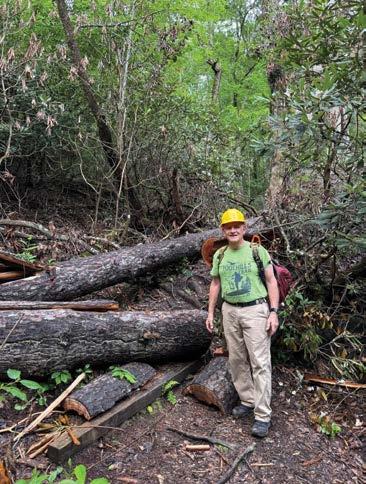
few stories to share from his past 40 years of adventures on the trail. If you are lucky enough to sit for a while with him, Heyward will entertain you with an “old yarn” at the same time he imparts words of wisdom, like don’t forget your SPOT satellite emergency locater (since your cellphone probably won’t work), your whistle, and the new edition of the Foothills Trail Guidebook (with a bright cover that won’t blend in with the woods if you set it down)!
According to Backpacker Magazine, the FT is one of the Top 50 Trails in the United States. This is due to the dedication of FTC members who developed the guidebook and who guide tours on the FT. Volunteers, including Heyward, also work countless hours to maintain the trail. Comfortable building a bridge or redesigning a staircase, he is a valuable resource. After Hurricane Helene, the FTC recorded 6,000 volunteer hours and opened the trail not long after the devastating storm.
Asked how he would sum up the benefits of the Foothills Trail, Douglass said, “The benefit of the Foothills Trail is that it gets people out there to see what a treasure we have.” There’s no better time than the present to join Heyward on the trail. You can be the next one to win the Peregrine Award for hiking the entire Trail, or you can hike one section. Regardless, the outdoors awaits!
Visit the FOLKS webpage @keoweefolks.org, Facebook @Friends of Lake Keowee Society or KeoweeFOLKS, and Instagram @friends_of_lake_keowee to find the latest information about the FOLKS Speaker Series.
(BELOW, FROM LEFT) Heyward Douglass helping clear the trail; Heyward with trimmer; Lisa Barker working on Burrell’s Ford trail.
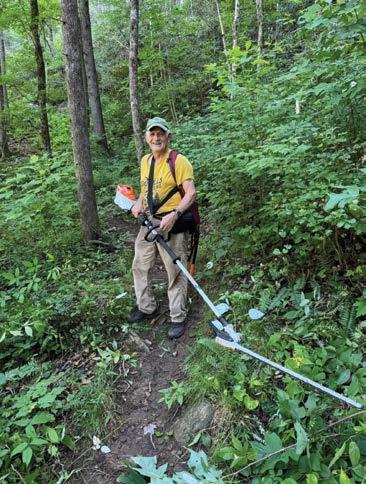
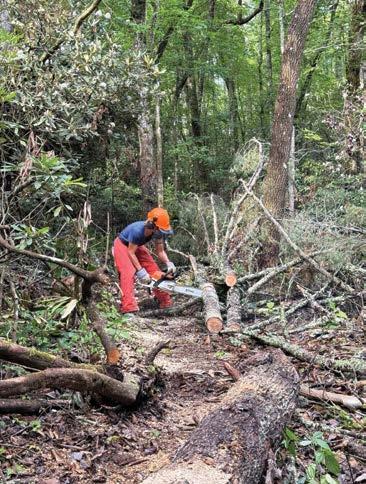

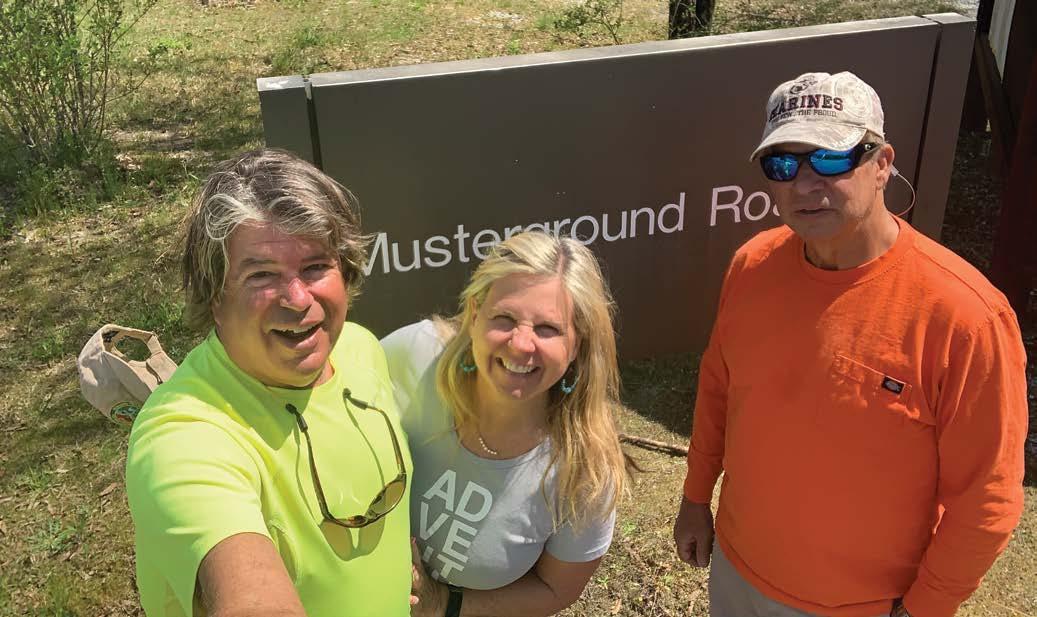
BY EMELYN JONES, President, Oconee Conservation Bank and Former Board Member, Upstate Forever
Have you ever been “called” to support a cause? School teachers are called to nurture children. Nurses and doctors are called to care for the sick. Soldiers are called to serve their country. Conservationists are called to protect natural resources. We all benefit from the joy and passion of these individuals in addition to the results of their work. We learn about initiative, goal setting, collaboration, and problem solving. I would like to share what inspired me to support conservation efforts.
My connection to nature and water was solidified in 2011 when I received a book listing the major waterfalls of South Carolina. I set a goal to hike to all 31 waterfalls, and as I checked each waterfall off the list, I rediscovered the beauty and tranquility of Oconee and Pickens Counties, particularly Lake Keowee. Each time I crossed the Highway 11 bridge, I admired the pure water and the glorious Blue Ridge Mountain range.
As my hiking confidence grew, I quickly discovered the endless benefits of spending time in nature. In 2018, I section hiked The Foothills Trail. The Foothills Trail is 76 miles long and extends
(continued on page 20)
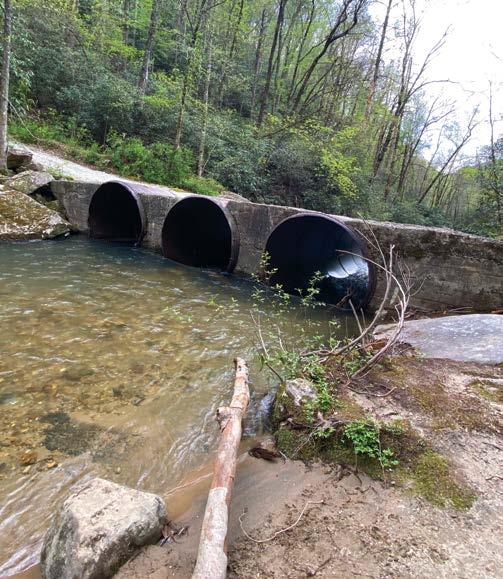

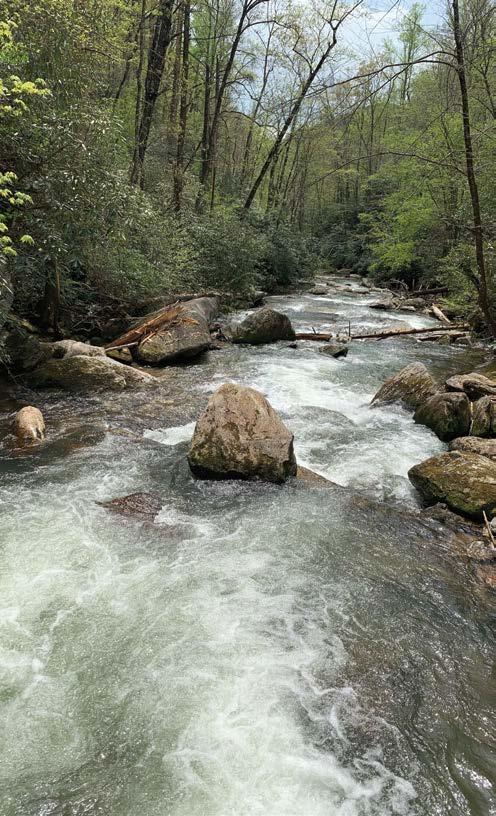
(continued from page 19)
from Table Rock State Park to Oconee State Park. Completing this trail on August 20, 2018, was one of the most challenging and rewarding events in my life.
It’s impossible to spend time in such stunning surroundings without feeling the need to preserve our setting. In 2018, I joined the Board of Directors for Upstate Forever, a nonprofit conservation group that focuses on balancing growth with the protection of our region’s natural resources and unique character. South Carolina is rapidly growing, and there is tremendous value in smart growth! After serving a four-year term as a board member of Upstate Forever, I chose to continue my work focused on my love of the land at a local level and was appointed by the Oconee County Council to the Oconee County Conservation Bank Board and elected chair in 2024. This board has provided funding to landowners to protect significant
natural resources, working farms, and historic, cultural, and scenic sites throughout Oconee County.
I strive to be a consensus builder — someone who brings people together around shared values. I believe this approach is especially important in matters of land conservation, where collaboration is essential for long-term success. By working with organizations like Naturaland Trust, the Oconee Soil and Water Conservation District, Upstate Forever, The Foothills Farmstead, and the South Carolina Farm Bureau, the OCCB has played a small but important role in advancing permanent conservation of valuable Oconee County property.
Since our board was established in 2011, we’ve helped protect 1,665 acres of farmland, woodlands, and historic properties in Oconee County. For perspective, that’s roughly the size of Keowee Toxaway State Park and Devils Fork State Park combined! Many of these lands have high-quality water sources that contribute
(continued on page 22)

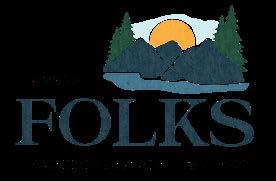
SEPTEMBER 10, 2025
Oconee County Sheriff
KEOWEE KEY | 5:00 PM - 7:00 PM
SEPTEMBER 2025 TBD
Fall Lake Sweep REGISTRATION INFO TBA
OCTOBER 28, 2025
FOLKS Annual Event
KEOWEE KEY | REGISTRATION TBA
Check our website for signups and updates @ KeoweeFOLKS.org

I received a book listing the major waterfalls of South Carolina. I set a goal to hike to all 31 waterfalls, and as I checked each waterfall off the list, I rediscovered the beauty and tranquility of Oconee and Pickens Counties, particularly Lake Keowee.
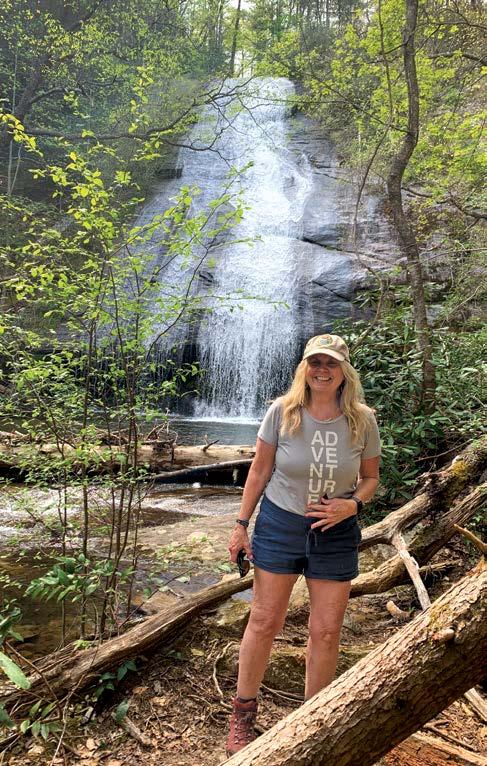
directly to major drinking water supplies. Importantly, this assistance to date has not been funded by taxpayer dollars but has been made possible through designated private or restricted funds.
Enjoy Emelyn’s account of her hiking trip to Hilliard Falls. Originally printed in the SCDNR Jocassee Journal, we hope the reprint (on facing page) will inspire you to continue to support FOLKS and the Lake Keowee Watershed.
BY EMELYN JONES, President, Oconee Conservation Bank and Former Board Member, Upstate Forever
In 2018, I fulfilled a goal when I hiked the 77-mile Foothills Trail with my husband, Neil, and our friend and neighbor, David Delahunty. My only regret was not taking the spur trail to Hilliard Falls, which is arguably one of the most elusive and remote falls in the Carolinas. These falls were named after Glenn Hilliard, one of the original founders of The Foothills Trail. I have worked with Glenn through our service on the Board of Upstate Forever, which deepened my desire to see this waterfall!
Three years later and after doing some research, I discovered that one of the trailheads to Hilliard Falls is Line Rock Gap which can be accessed via Musterground Road at Duke Energy’s Bad Creek Facility. We had been on this road a few times to hike to Lower Whitewater Falls but never ventured as far as we needed to today. The gravel road is only open in the month of April, and from September 15 through January 2. One of my favorite resources when exploring is my “DNR Jim Timmerman Natural Resources Area at Jocassee Gorges” map. This free map can be found at many of the State Parks in this area and is a must for anyone wanting to discover the riches of the Gorges. Pulling out my DNR map, the trailhead at Line Rock Gap was located about six miles from Bad Creek, and on a perfectly sunny April day, the tenacious trio of Neil, David and Em set out for a memorable venture. We packed lots of water and fruit and set off to Musterground Road in Neil’s Jeep Gladiator … and yes, you do need a 4x4 high clearance vehicle (and a keen sense of adventure!) for this quest. It is not for the faint of heart! What a wonderful gift it was to be heading to our destination with no time limits! As we drove past Bad Creek Access, we had beautiful views off to our right of Lake Jocassee, the purest lake in South Carolina. There were many “mini” waterfalls along the way that tempted us to stop and savor. My favorite stop was about five miles in, right before we crossed The Thompson River. We strolled along a beautiful sandy bank to get a great view of the extremely “unique” bridge over the Thompson built from old boilers,
drainpipes, or something of their likeness!!
Crossing Whitewater and Thompson Rivers was a thrill that provided first class views. These are two of the four mountainous rivers that feed Lake Jocassee with their beautiful, cold, clear water, providing many of us with our drinking water. If you believe, like I do, that water is our most valuable resource on the planet, this is a glorious sight!
Six miles deep into the rugged Jocassee Gorges, we pulled over to the left at Line Rock Gap and found the red gate at the trailhead. Watch carefully for the gate as it is easily missed! Here is where we set out on foot to hike the 4 mile spur trail to The Foothills Trail. Connecting with the trail felt familiar as we turned right and headed towards Horsepasture River.
As my mother says, nature is the best gardener! We especially enjoyed the blooms of the wild dogwoods and mini purple irises as we hiked. About two miles in, we found the sign pointing us to our final destination — the 50-foot spectacular waterfall that is Hilliard Falls! I was struck by the solitude and peacefulness of the pools beneath the falls that flow into Bearcamp Creek. The water temperature was a cool 58 degrees (yes, I carry a water thermometer in my backpack!) which made me think how refreshing it would feel in the heat of the summer. Mission Accomplished! Was it worth the wait? Absolutely! And just like that, it was time to head back.
On the hike out, we ran into some thru-hikers from North Carolina looking for some guidance on campsites. There is such camaraderie on the trail, and I was happy for the fiveminute rest as we stopped to chat with them. A gentle rain cooled us off, reminding me that we were in the only temperate rain forest east of the Rockies. In all, the round trip hike was 4.4 miles. There was a good bit of elevation but nothing that our easy and steady pace couldn’t handle.
Reflecting on the day, I continue to be thankful for the visionaries who preserved this area and who continue to work tirelessly to protect this special, special place in our state and our country. There is much work to be done, and the time is now! Please get out and enjoy the outdoors — and let me tag along!

BY MELISSA HIGGS, Community Engagement Director, FOLKS and MAC STONE, Executive Director, Naturaland Trust and Conservation Photographer
For the past year and a half, I have admired the talent and knowledge of Mac Stone, conservation photographer and Executive Director of Greenville-based Naturaland Trust. A senior fellow with the International League of Conservation Photographers, TED speaker and National Geographic Explorer, his internationally awardwinning photography has been featured in National Geographic and Garden & Gun magazines. Yet, Mac is down-to-earth and grounded by his connection with nature and family
When perusing his Facebook page, Mac Stone Photography, you enjoy up-close encounters where his cameras capture animals in small spaces and sunrise views high atop river bluffs. Each photo demonstrates his respect for the natural world, ability to adapt to different circumstances, creativity, and intuition. Originally from Florida, Mac continues to promote the preservation of The Everglades and wetlands around the world. His coffee table book, Everglades: America’s Wetland, is in its second printing and is a rare look into the heart of one of the country’s largest wilderness areas.
Mac is quoted in Garden & Gun’s April 2024 edition. “The way you are injecting your perspective into an image is what ‘makes’ a photograph rather than ‘takes’ it.” This perspective has allowed Mac Stone to
bring wild places to people who didn’t know their value before they saw his photographs. “If we can convince people their backyards are important and beautiful, pride will follow. And with a sense of pride comes a sense of ownership. With ownership comes long-term stewardship.”
Upstate South Carolina has benefited from Mac’s work for the past 13 years. As Executive Director of Naturaland Trust, he works with willing landowners to purchase their property by winning competitive grants from state, federal and local sources. Stone’s Naturaland Trust Facebook post notes, “it’s one of the most fulfilling things I do, buying land and protecting it forever. I love it. We’re small, but mighty and unique in that every dollar raised goes straight to buying land, not overhead.” Naturaland Trust currently owns and manages over 9,000 acres and has played a direct role in conserving and protecting another 100,000+ acres (Naturaland Trust).
The Lake Keowee Watershed incorporates the Little River and Keowee River basins, which include properties along Highway 11 that Naturaland Trust has worked to preserve. Eastatoee Ridge, Little Eastatoee, Nine Times Forest, Logger Court, White Branch and Gilstrap Mountain are a few within Pickens County and they are part of a nearly 4-mile stretch that Naturaland Trust has protected over the last ten years. These properties are vital for maintaining the scenic qualities of
(continued on page 26)
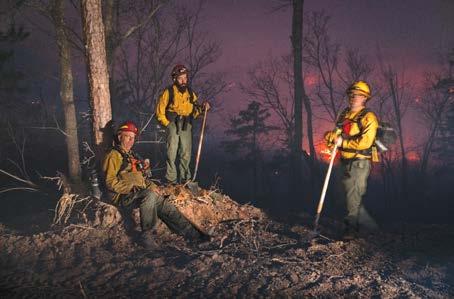
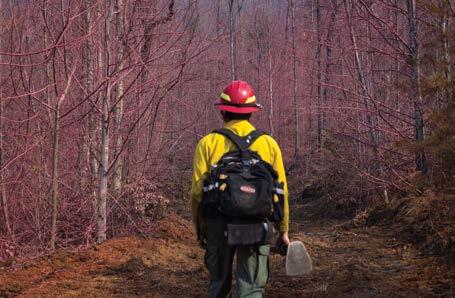
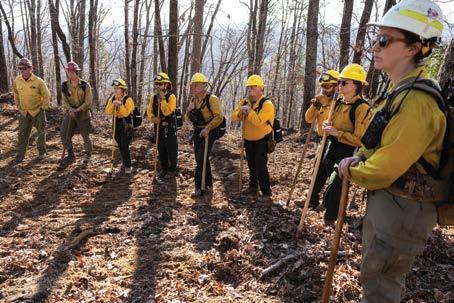
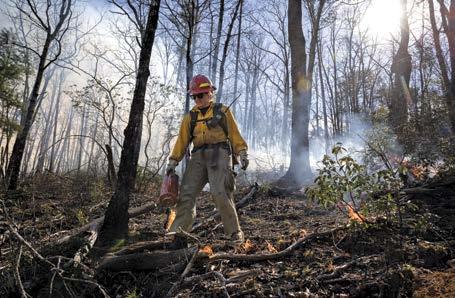
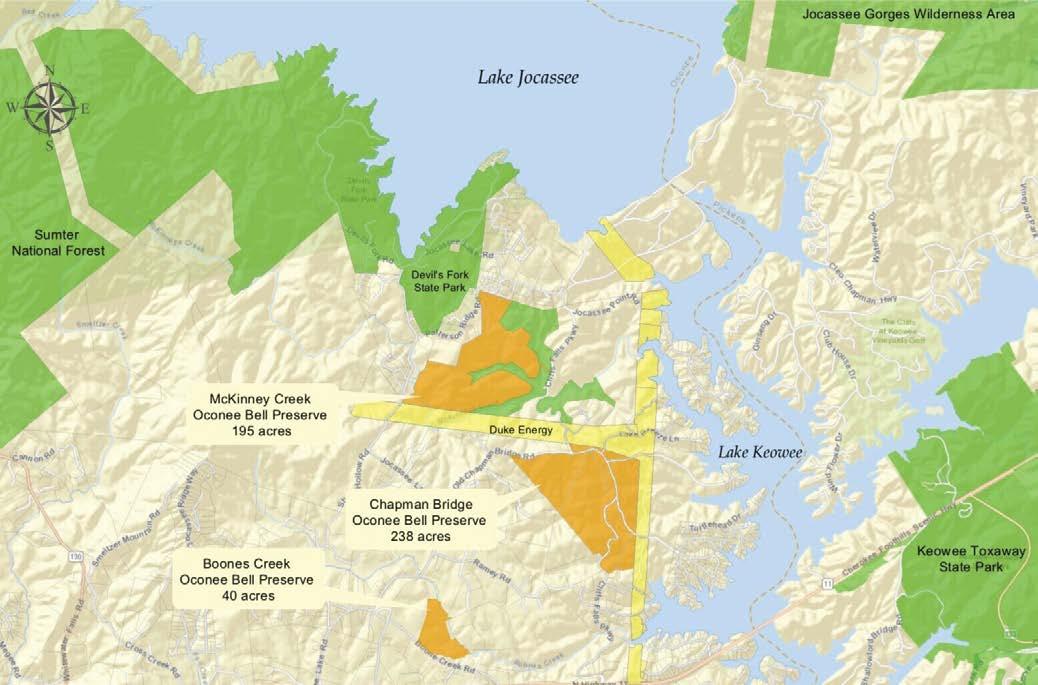
(continued from page 25)
Highway 11 and they also provide immense recreational value to the thousands of visitors who hike and fish on Naturaland Trust property each year.
The SC Department of Natural Resources recognized the Trust’s efforts in their Jocassee Journal. They recounted how Mac and President of Naturaland Trust, Frank Holleman, worked quickly to save 500 acres just west of Lake Jocassee, prime habitat for the Oconee bell. Since 60% of the global habitat for the species was eliminated with the Jocassee dam, the naturally occurring flowers were an important find. Naturaland Trust organized quickly to purchase several properties with the help of private, state, and local donors. Their ability to recognize the importance of strategic properties and to act on opportunities made a difference for the entire region.
Wildlife isn’t constrained to property lines. The Blue Ridge escarpment as a whole requires care and attention. In April, the Table Rock Complex Fire, started by teens smoking, took 19 days to contain, burning 15,000 acres of forest. Mac was there documenting the painstaking process of handling wildfires. His tribute to the wildland firefighters shows how important it is to think about the consequences of certain actions. The fire is the largest wildfire recorded in Upstate history.
Even after a wildfire, there is work to be done. Exposed soil must be stabilized to prevent erosion and containment lines have to be put in place to divert surface water runoff. In addition to the damage and contamination,
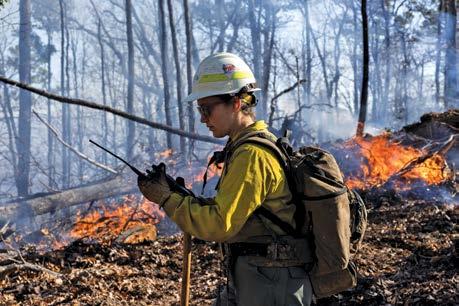
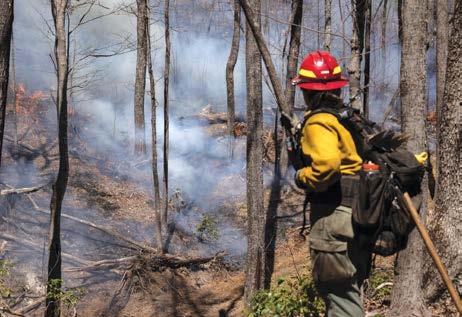
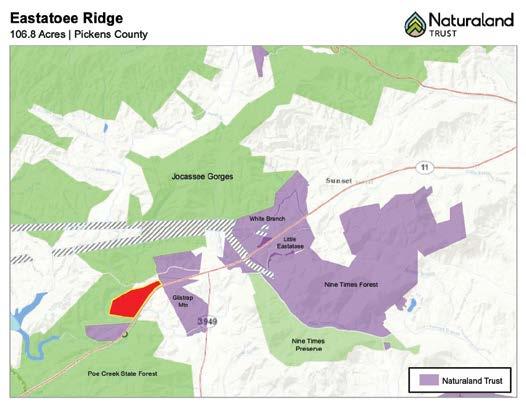
the Table Rock Fire cost over $1 million dollars because an air tanker had to drop retardant on the fire, and the park lost over $50,000 in revenue because they had to cancel reservations.
You may have heard the saying, “Actions speak louder than words.” Mac’s images from the fire portray the actions of local heroes and the devastation caused by the wildfire. Hopefully, they will lead to further action to prevent wildfires.
Everyone has a role to play in conservation–the people who visit our parks and public lands, the emergency personnel, the landowners, the legal representatives, the organizations that maintain preserved lands, and the artists and writers who spread the message. Everyone can make a difference. Small acts matter. As Stone says, “We’re lucky to live in such a vibrant and beautiful place. One of the most meaningful things we can do as citizens is to channel that gratitude back to its source.”
“We’re lucky to live in such a vibrant and beautiful place. One of the most meaningful things we can do as citizens is to channel that gratitude back to its source.”




BY DALE WILDE, President, FOLKS
As wildfires become increasingly prevalent, the significance of proactive measures to safeguard communities cannot be overstated. In light of the recent fires at Table Rock and Persimmon Ridge, the importance of local homeowners and homeowner associations in this area having risk assessment and fire mitigation plans is vital. The Upstate has experienced several drought conditions in recent years, most notably in 2016, 2021, 2023 and 2025. These conditions, as well as the impacts from Hurricane Helene left a considerable number of downed trees increasing the fire danger in this area as evidenced by the recent Table Rock and Persimmon forest fires.
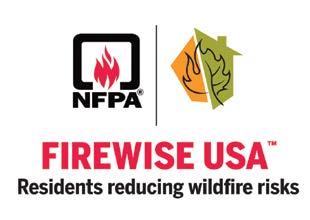
Several lake area communities have adopted the National Fire Protection Association (NFPA) FireWise USA Program, which was established in 2002. Firewise USA is a nationally recognized
voluntary program that provides a framework to help neighbors and home-owner associations (HOAs) in a geographic area organize and take action to reduce wildfire risks in their local area. This initiative not only enhances the safety of residents but also fosters a sense of community and responsibility. A FireWise program equips homeowners with the knowledge and resources to reduce wildfire risks. By educating residents about fireresistant landscaping, proper maintenance of properties, and safe evacuation routes, HOAs can significantly decrease the likelihood of devastating forest fires impacting their neighborhoods. Regular community workshops and drills can empower residents to act quickly and effectively in the event of a forest fire spreading into their neighborhood.
Communities that prioritize safety and disaster preparedness often see a positive impact on property values. A FireWise designation can make a neighborhood more attractive to
(continued on page 30)
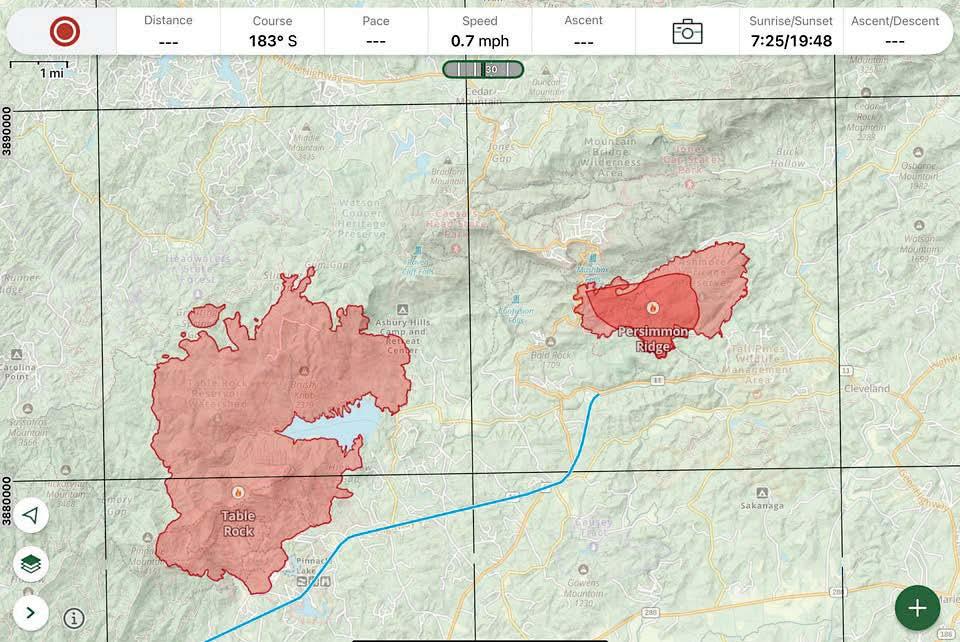
(continued from page 29)
potential buyers who value safety and community engagement. The assurance of being part of a proactive community can enhance the overall appeal of a neighborhood, making it a desirable place to live.
Implementing a FireWise program enables residents to come together to address a shared concern. Collaborative efforts to maintain fire safety build relationships and creates a sense of belonging and collective responsibility. This engagement can lead to stronger community bonds and a more supportive environment.
Many FireWise programs are recognized by state and federal agencies, making them eligible for grants and funding opportunities. HOAs that adopt such programs can leverage these resources to improve community infrastructure and safety measures. This financial support can be crucial in implementing effective fire prevention strategies and ensuring ongoing education and training for residents.
The importance of an HOA having a FireWise program cannot be understated. By prioritizing fire safety, HOAs not only protect their residents but also enhance property values, promote community engagement, and secure vital resources. As wildfires continue to pose a significant threat, adopting a FireWise program is a proactive step that every HOA should consider to ensure the safety and resilience of their community.
For more information about preparing for wildfires, visit nfpa.org/education-and-research/ wildfire/firewise-usa .






BY JACKSON HIGGS, Former Jack Lewis Watershed Scholarship
Recipient and Griffith Scholar, Presbyterian College Student
In this edition, FOLKS is pleased to highlight FOLKS Board Member John Hains. Dr. Hains, a retired professor from Clemson University taught limnology and freshwater ecology in the Department of Biological Sciences. Before that, he was a Research Biologist in the Environmental Laboratory of the Engineer Research and Development Center, U.S. Army Corps of Engineers, during which time he led research on Richard B. Russell, J. Strom Thurmond, and Hartwell Lakes, as well as other projects around the USA. Prior to that, he was a biologist for Duke Power and conducted studies on the Keowee-Toxaway Project and elsewhere throughout the DPC service area. Although he has conducted limnological and ecological studies on many lakes and streams throughout the United States, lately, he spends time on lakes in the Savannah River Basin, including the Keowee-Toxaway Project. He continues to be active as an emeritus faculty member, works with invasive species, and performs identifications of troublesome aquatic plants and algae for the Clemson Problem Plant Clinic.
Since 1993, in many editions of the KEOWEE (formerly The Sentinel) magazine, Dr. Hains has graciously provided his expert guidance on a variety of topics, including dam construction, Hurricane Helene, the Upper Savannah River Basin, lake coves and invasive species, to name a few. His commitment to educating individuals about the importance of conserving Lake Keowee and its watershed is commendable. He has enabled us to enter the vast world of limnology through his articles and has helped us gain a greater appreciation for Lake Keowee and its watershed.
An expert limnologist, Dr. Hains has not limited his study to
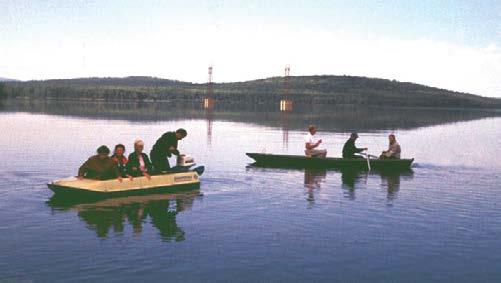
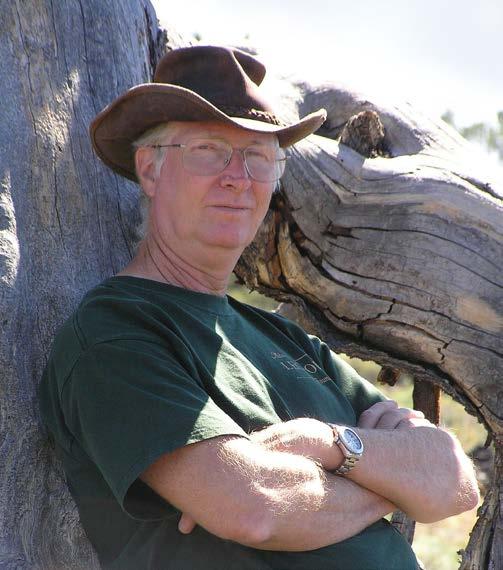
the biological and chemical features of lakes. He also addresses development issues. In his articles for FOLKS, he has demonstrated an understanding of how various stakeholders, such as Duke Energy and lake residents, impact the water quality and ecology of the lake. Dr. Hains is a staunch advocate for Lake Keowee and the Upper Savannah River Basin’s ecosystems. In his writing he often warns about the dangers of not conserving our lake. For example, his article, “What Are We Drinking,” reminds us that Lake Keowee is a source of drinking water for many local residents. We are fortunate to have a clear, clean lake because the Lake Keowee watershed has “few sources of pollutants.” To maintain the quality of the lake, Dr. Hains adds that “careful and diligent protection of the surrounding lands” will allow for pristine, healthy reservoirs. He contrasts meticulous conservation with “soil disturbance and the development of housing [and] roads,” which can lead to a rapid degradation in water quality.
Along with discussing ecology and water quality in his articles, Dr. Hains has also written about what makes Lake Keowee unique and why it is worth preserving. In his article, “Coves and Transitions (Trouble in Paradise?),” Dr. Hains explains that Lake Keowee has a complicated shape because man-made reservoirs typically fill tributary streams in a way that forms “long, narrow coves.” Meanwhile, natural lakes that are formed by glaciers or other processes typically have a rounder shape. Lake Keowee’s unique appearance allows individuals to experience these coves, which are “good places to enjoy the lake,” according to Dr. Hains. In coves, recreation is closer to the shore, there is less wind to cause big
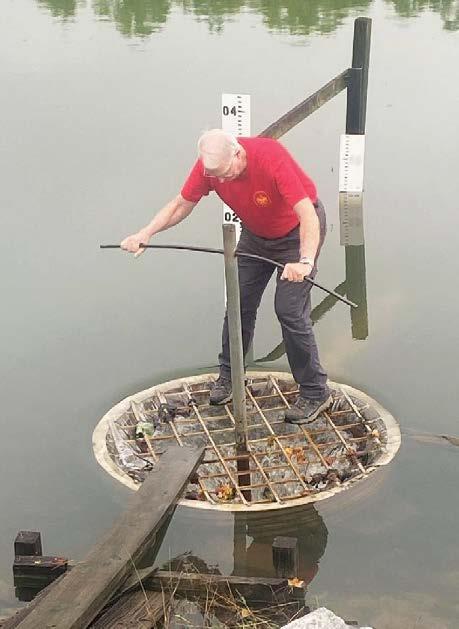
waves, and boat wake and speed is often controlled. However, Dr. Hains also reminds us that along with enjoying coves, we also have a responsibility to preserve coves and greater Lake Keowee. Residents should recognize their shared interests and consider their lake community when supporting conservation efforts. The mission of FOLKS to “preserve, protect and enhance Lake Keowee and its watershed through advocacy, conservation, and education” can be applied to the communities surrounding coves because these areas can be seen as microcosms of the larger lake and watershed. In other words, by focusing on advocacy, conservation, and education within these smaller communities, a similar positive impact can be achieved on the larger ecosystem.
In recognition of his tireless efforts to educate individuals on the importance of lake conservation and advocate for its continued preservation via articles in The Sentinel and KEOWEE magazines, FOLKS is proud to spotlight Dr. John Hains. His expertise in limnology and passion for Lake Keowee makes him an invaluable resource for anyone interested in learning about our lake. Thank you, Dr. Hains, for your continued support of FOLKS and all your hard work!
DID YOU KNOW? John Hains uses his experiences as a researcher to provide insights and guidance for Lake Keowee and the Upper Savannah River Basin (USRB). In the next edition of KEOWEE, look for a synopsis of the USRB Plan, which was developed by John and colleagues on the USRB Council.
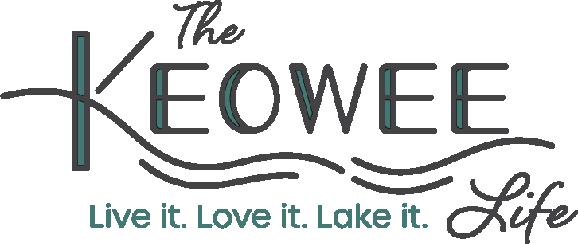










We appreciate the support of our Corporate and Business Members and know that they will appreciate your patronage. When you do so, please thank them for supporting FOLKS.
Blue Ridge Electric Cooperative, Inc.
City of Seneca
Duke Energy
Greenville Water
Greg Coutu — Allen Tate Realty
Keller Williams Seneca Keowee North — Patti & Gary Cason, Melissa Cason Custer, Corey Custer
Keowee Key Property Owners Assn.
Melanie Fink and Associates — Allen Tate Realty
Oconee Federal Savings & Loan
Stoneledge Home Owners Association
The Reserve at Lake Keowee
Action Services of Oconee, Inc
Advocates for Quality Development
Allen Tate — John Pulliam
Backwater Landing
Blue Ridge Bank
Carolina Bay Healing
Spring Waters
Carolina Wealth Management
Classic Lighting
Custom Dock Systems, Inc.
Dolly’s Roofing
Dorn’s Landscape Service
For the Birds, Inc.
Golden Corners Lakes
Sail & Power Squadron
Goldie & Associates
Justin Winter & Associates
Forbes Global Properties
Keowee North Marine
Kingfisher Maps
Kroeger Marine Construction
Lake Keowee Marina
Metal Lake Maps — Ken Van Natta
Northwestern Supply
Porch Conversion of Seneca
Rainmaker Ponds and Irrigation
Sexton Griffith Custom Builders, LLC
Shorescapes, Inc
Strickland Marine and RV
The Boat Dock Company
The Cliffs at Keowee HOA
The Happy Berry
The Lake Company — Lake Keowee
The Wine Emporium
T & M Custom Docks
Upstate Insurance Agency
Vassey Financial Planning and Investments
Waterford Pointe HOA

Designed to advance public knowledge and skills for safer boating in the Upstate, learn about State and local regulations, safety equipment, how to handle emergencies, anchoring, trailering, navigation rules and aids, personal watercraft operation, knot tying and much more. After completing the course, there is an option to have on-the-water training, if desired.
WHEN: Three nights of instruction with the exam included on the third night. Meets three consecutive Tuesdays – 9/9, 9/16 and 9/23 from 6:00 to 8:30 pm, with the exam on the 23rd.
WHERE: St. Mark United Methodist Church in Seneca, SC; however, if appropriate, classes will be held via an online Zoom meeting with a final in-person exam session.
COST: $35 for a manual and supplies. The manual can be shared by family members.
Pre-registration is requested at least 2 weeks in advance. To sign up call Ron Osburn, 864-972-2434, or email Ron at ozbrn@bellsouth.net
For membership and additional information, visit our website at ABClubGCL.org or on Facebook @abclubgcl.
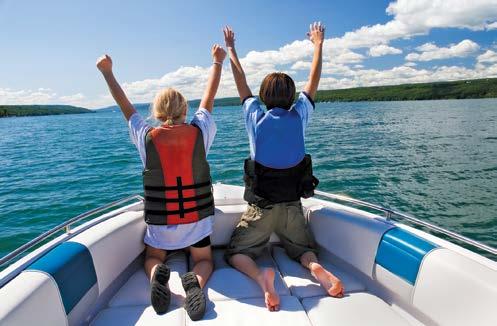
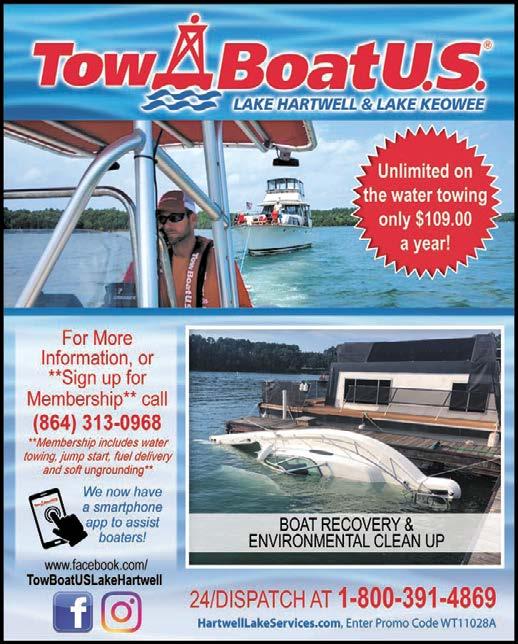



FOLKS’s 30-year history has been built upon the pillars of our mission statement that clearly focuses our efforts on advocacy, conservation, and education—ACE.
Our achievements over the past few years:
• Stakeholder for relicensing efforts in the watershed
• Uniting voice in the state for boating safety
• Sustained efforts with litter cleanup and prevention
• Ombudsman and information resource for members and communities
• Adopt-a-Stream water quality monitoring
• Bi-annual Lake Sweeps and Island Keepers programs
• Installation of fish habitat—Since 2022 FOLKS installed more than 215 Dock Pro Kits and over 400 larger fish habitats throughout the lake
• Bluebird nesting boxes and osprey platforms
• Publication of the magazine — KEOWEE
• Jack Lewis Watershed Stewardship Scholarship Program — We have selected 6 local high school students for the 2024–25 program.
• Bill Miller Adopt-a-Stream Lending Library — Provided $5,000 funding for local area schools to support stream monitoring efforts
• Outreach to local Home Owners Associations
• Presentations to at Newcomers, Rotaries, and community presentations at World of Energy
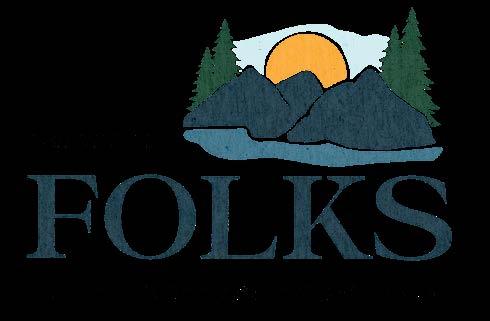
We are excited about continuing our stewardship of preserving the lake and serving as stakeholder on important lake and watershed issues. We are focusing our efforts this year on more community engagement and working with local area schools to help them develop meaningful STEM projects. Join our team of volunteers and become a member!

Our membership form is also online at KeoweeFOLKS.org or by scanning the QR code above. Dues and donation are tax-deductible.
FOLKS is a 501(c)(3) public service watershed organization.
Option for digital copy only of the newsletter






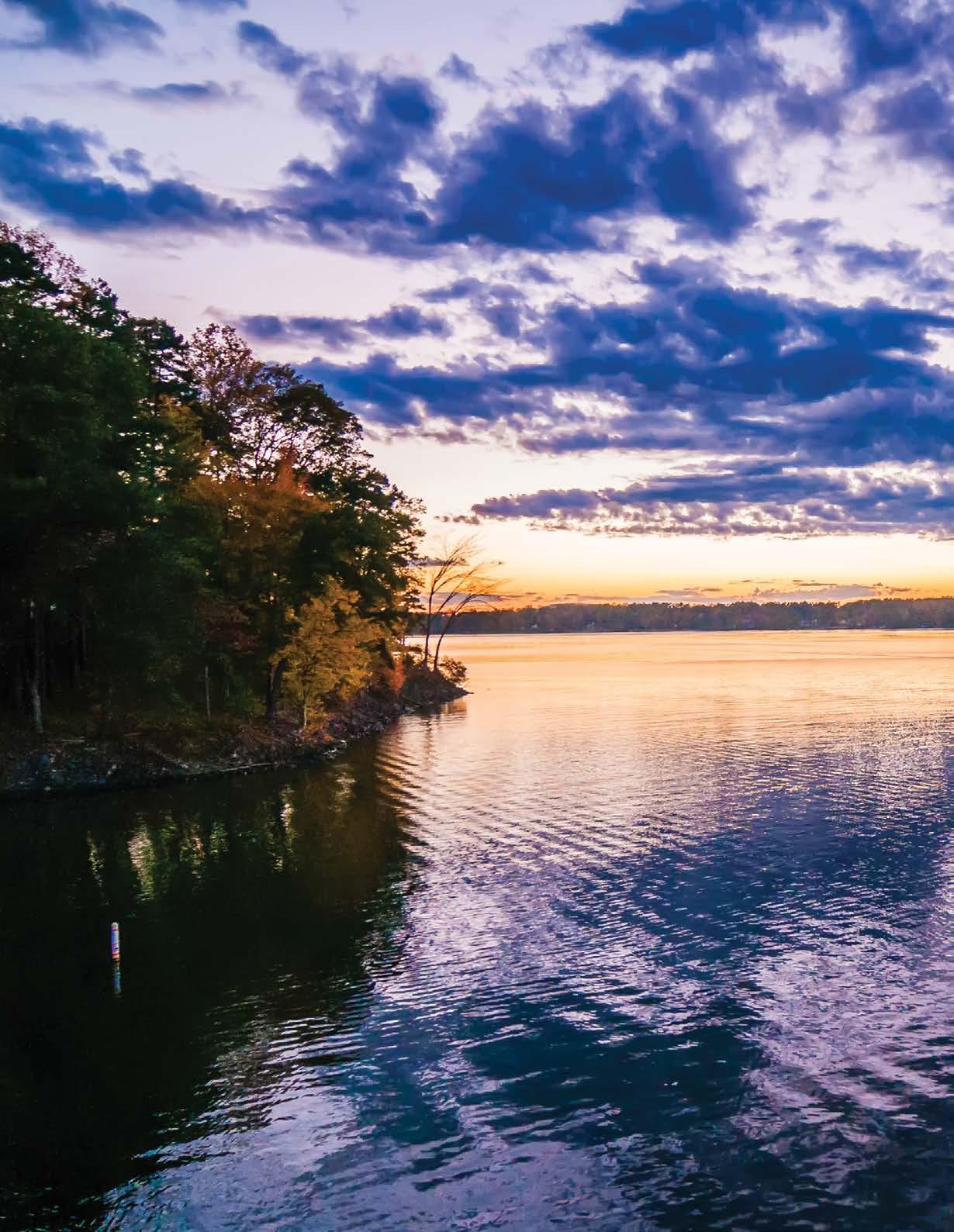
864.638.6642





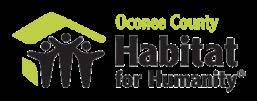












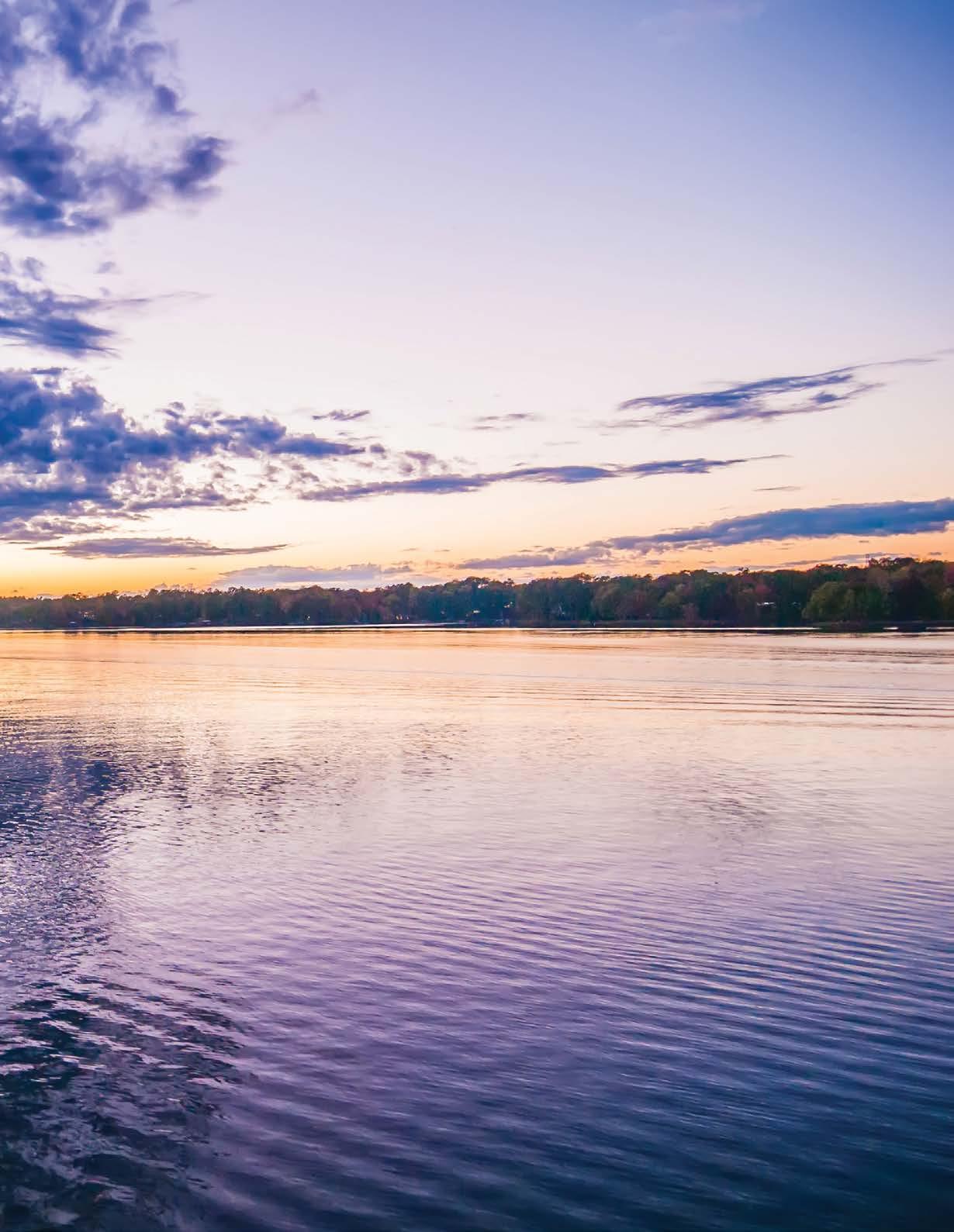




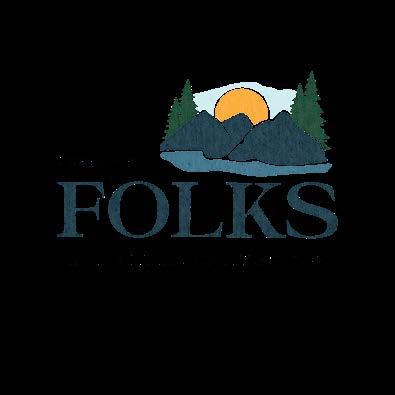
C/O The Alliances
1201 N. Fant St., Anderson, SC 29621
U.S. POSTAGE PAID
SENECA, SC PERMIT NO. 70
BY DALE WILDE, President, FOLKS
FOLKS began publishing its Sentinel Newsletter in 1993 and many long-time FOLKS members may remember that we used to spotlight new members, corporate and business members and advertisers. In recent years, in what is now our KEOWEE magazine, we stopped this important practice of recognizing those businesses who have helped us financially and supported our mission thus enabling FOLKS to continue make improvements. With this first installment of the new Spotlight, I am pleased to showcase Patti and Gary Cason and The Cason Group/Keller Williams Seneca-Keowee North.
Patti Cason and her husband Gary began their careers in real estate in the early 2000s. In 2013, they joined the Keller Williams team and have built a remarkable business as The Cason Group, which also includes daughter Melissa Cason and Melissa’s husband, Cory Custer. The whole family has had a strong commitment to Lake Keowee and has enjoyed many years living in the lake community.
In January 2015, The Cason Group joined FOLKS as business members and began advertising in The Sentinel newsletter. They realized the importance of promoting the lake lifestyle as they helped property buyers purchase homes and land around the watershed. The Cason Group has been
“Patti Cason has an infectious spirit of joy and kindness. Her willingness to commit time, energy, and funding into our mission is very much appreciated. We thank Patti and the entire Cason group for their 10 years of support.”
– The FOLKS Board of Directors
committed to our mission of preserving the lake through advocacy, conservation, and education. They have continued this commitment through the years by increasing their advertising, sponsoring our annual events, and by funding eight very successful Speaker Series this year, on a variety of key topics including three large events at the Keowee Key Event Center focused on the Foothills Trail, an Update on the Warpath Public Ramp, and the Oconee County Sheriff’s Update. The Casons have also attended all the speaker series events and provided volunteer hours helping with the setup of the events and the welcoming of attendees. Their efforts at the events have been an incredible help!
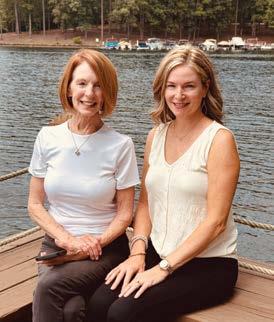
The Cason Group has also gone a step further by providing two-year memberships to their new home buyers along with a FOLKS canvas gift bag. Their heartfelt generosity has helped to build our membership and allow us to cultivate new volunteers.